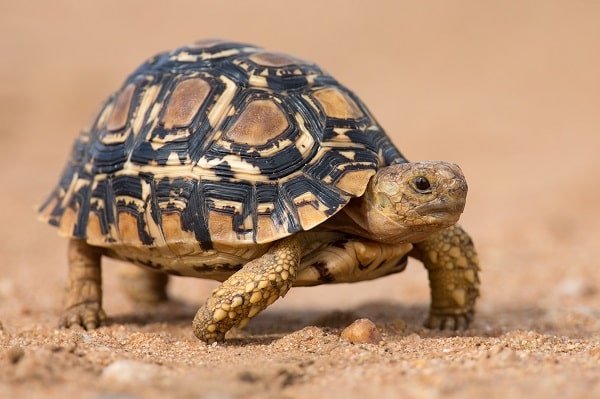
So, is this tortoise the right fit for someone just starting out? Here’s the thing: while they are a popular choice, there are a few important factors to consider. Caring for a leopard tortoise involves understanding their needs, habitat, and diet. If you’ve got a patient mindset and are ready to learn, you might find that these tortoises make wonderful companions.
What is a Leopard Tortoise?
Leopard tortoises are native to the savannas and grasslands of Africa. They’re known for their distinctive, beautiful shells, which can grow quite large and impressive over time. This fascinating reptile can live for over 50 years in captivity, making them a long-term commitment. When you think about adopting a leopard tortoise, it’s a bit like adopting a pet dog—but one that doesn’t bark or need walks!
Typically, these tortoises can grow anywhere from 10 to 18 inches in length, depending on their environment and diet. They have a sturdy build, with a domed shell that serves as a protective armor. A healthy leopard tortoise is lively and curious, often exploring its surroundings rather than hiding away like some other reptiles.
Ideal Habitat for Your Leopard Tortoise
Creating the right environment for your leopard tortoise is crucial. Think of it like setting up a cozy home for a friend who’s moving in. These tortoises thrive in warm, dry conditions, so you’ll want to replicate their natural habitat as closely as possible.
Indoor vs. Outdoor Enclosure
– Indoor Setup: If you plan to keep your tortoise indoors, use a spacious enclosure with plenty of room to roam. A large terrarium or a customized indoor pen works well. Make sure to include a basking area with a heat lamp to keep things warm. The temperature should be around 90°F in the basking spot and around 70°F at the cooler end.
– Outdoor Setup: If your climate allows, an outdoor pen can be ideal. Ensure it’s secure from predators and has access to shade and water. It’s essential to provide areas where your tortoise can burrow and explore.
Don’t forget about lighting! Leopard tortoises need UVB lighting to help them absorb calcium, which is vital for their health. Without it, they can develop serious health problems.
Feeding Your Leopard Tortoise
When it comes to feeding your leopard tortoise, variety is key. Think of their diet as a colorful salad bar filled with goodies. They thrive on a mix of grasses, weeds, and leafy greens. Here are some favorite foods:
- Dandelion greens
- Collard greens
- Endive
- Cactus pads
It’s essential to avoid feeding them high-protein foods like fruits and vegetables that are sugary. While those treat foods may be tempting, too much can lead to health issues like shell deformities. Instead, stick to a diet that mimics what they would naturally find in the wild.
Hydration is also crucial. Make sure your tortoise has access to fresh, clean water, and consider soaking them regularly to help keep them hydrated, especially in dry climates.
Handling and Socialization
You might be wondering how to bond with your leopard tortoise. Unlike dogs, these tortoises aren’t particularly affectionate, but they can become accustomed to you. Think of them like a roommate that enjoys your company but prefers to do their own thing.
Start by allowing your tortoise to become familiar with your presence. Spend time near their enclosure, talking softly or offering food. Over time, they may associate you with positive experiences. When handling your tortoise, always support their body, and be gentle. Tortoises can be skittish, so it’s important to approach them calmly.
Remember, socialization isn’t just about handling. You can enrich your tortoise’s life by offering different types of substrates in their enclosure, like hay or soil. This allows them to dig and explore, making their environment feel more dynamic.
Common Health Issues to Watch For
Like all pets, leopard tortoises can face health issues. As a beginner, it’s essential to know what signs to look for, just like you would for a friend who’s not feeling well. Some common issues include:
– Respiratory infections: Look for labored breathing or wheezing.
– Shell rot: This can happen if their shell is constantly damp, leading to soft or smelly areas on the shell.
– Metabolic bone disease: Often due to poor diet and lack of UVB light, this can cause weakness and deformities.
Regular vet check-ups are a good idea, especially since you want to keep your tortoise healthy and happy. Don’t hesitate to consult a vet who specializes in reptiles if you notice any unusual behavior or symptoms.
Is the Leopard Tortoise Right for You?
Before you rush into adopting a leopard tortoise, think carefully about your lifestyle. These tortoises require a commitment similar to that of a cat or dog. They thrive on consistency, so if you travel often or have a busy schedule, you might need to reconsider.
Also, leopard tortoises can grow quite large, so you’ll need to plan for their space requirements as they mature. If you’re able to provide a suitable environment and have the time to dedicate, then a leopard tortoise could be a perfect pet for you.
To sum it up, while leopard tortoises are rewarding pets, they require dedication, knowledge, and care. It’s all about creating a beautiful life for your new companion.
In conclusion, if you’re patient and ready to embrace the responsibility, owning a leopard tortoise can be a fulfilling journey. With their unique characteristics and the joy they bring, you might just discover the perfect pet waiting in that little shell!
